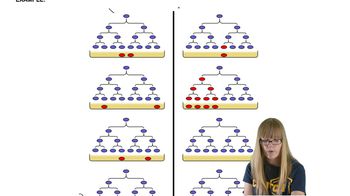Table of contents
- 1. Introduction to Genetics51m
- 2. Mendel's Laws of Inheritance3h 37m
- 3. Extensions to Mendelian Inheritance2h 41m
- 4. Genetic Mapping and Linkage2h 28m
- 5. Genetics of Bacteria and Viruses1h 21m
- 6. Chromosomal Variation1h 48m
- 7. DNA and Chromosome Structure56m
- 8. DNA Replication1h 10m
- 9. Mitosis and Meiosis1h 34m
- 10. Transcription1h 0m
- 11. Translation58m
- 12. Gene Regulation in Prokaryotes1h 19m
- 13. Gene Regulation in Eukaryotes44m
- 14. Genetic Control of Development44m
- 15. Genomes and Genomics1h 50m
- 16. Transposable Elements47m
- 17. Mutation, Repair, and Recombination1h 6m
- 18. Molecular Genetic Tools19m
- 19. Cancer Genetics29m
- 20. Quantitative Genetics1h 26m
- 21. Population Genetics50m
- 22. Evolutionary Genetics29m
17. Mutation, Repair, and Recombination
Spontaneous Mutations
Problem 1c
Textbook Question
How do we know that DNA repair mechanisms detect and correct the majority of spontaneous and induced mutations?
 Verified step by step guidance
Verified step by step guidance1
Understand that DNA repair mechanisms are essential for maintaining the integrity of the genome. These mechanisms are studied through experiments that measure mutation rates in cells with and without functional repair systems.
Review the concept of spontaneous and induced mutations. Spontaneous mutations occur naturally due to errors in DNA replication or chemical changes, while induced mutations are caused by external agents like radiation or chemicals.
Examine experimental evidence where researchers compare mutation rates in wild-type cells (with functional repair systems) to those in mutant cells lacking specific DNA repair pathways. A higher mutation rate in repair-deficient cells indicates the role of repair mechanisms in correcting errors.
Consider the use of mutagenic agents in experiments. Scientists expose cells to mutagens and then measure the frequency of mutations. They observe that cells with intact repair systems have significantly lower mutation rates compared to repair-deficient cells, demonstrating the effectiveness of repair mechanisms.
Analyze the molecular mechanisms of specific DNA repair pathways, such as base excision repair, nucleotide excision repair, and mismatch repair. These pathways are studied using biochemical assays and genetic analysis, which show how they detect and correct DNA damage, preventing mutations from becoming permanent.
 Verified video answer for a similar problem:
Verified video answer for a similar problem:This video solution was recommended by our tutors as helpful for the problem above
Video duration:
1mPlay a video:
Was this helpful?
Key Concepts
Here are the essential concepts you must grasp in order to answer the question correctly.
DNA Repair Mechanisms
DNA repair mechanisms are cellular processes that identify and correct damage to the DNA molecules that encode an organism's genome. These mechanisms include various pathways such as base excision repair, nucleotide excision repair, and mismatch repair, which work to fix different types of DNA lesions. Understanding these processes is crucial for comprehending how cells maintain genetic integrity and prevent mutations.
Recommended video:
Guided course

Repair Pathways
Spontaneous and Induced Mutations
Spontaneous mutations occur naturally during DNA replication or due to internal cellular processes, while induced mutations result from external factors such as radiation or chemical exposure. Both types of mutations can lead to changes in the genetic code, potentially affecting protein function and cellular behavior. Recognizing the sources and types of mutations helps in understanding the necessity and effectiveness of DNA repair mechanisms.
Recommended video:
Guided course

Spontaneous Mutations
Experimental Evidence for DNA Repair
Experimental evidence for the effectiveness of DNA repair mechanisms comes from various studies, including those using mutant strains of organisms that lack specific repair pathways. These studies often show increased mutation rates in these mutants compared to wild-type organisms, demonstrating that DNA repair systems are essential for correcting errors and maintaining genomic stability. Such evidence supports the conclusion that these mechanisms can detect and correct the majority of mutations.
Recommended video:
Guided course

Repair Pathways
Related Videos
Related Practice
Textbook Question
Describe a tautomeric shift and how it may lead to a mutation.
1100
views


